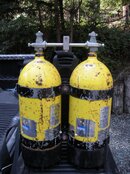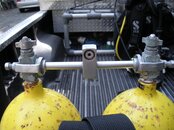Just picked up a set of 1961 voit 50's 1880 psi. They came with a manifold that connects the two valves. The neck is smaller than normal and I'd like to keep it as "retro" as possible. Can those old valves be refurbished? And is an old connector dependable enough?
You are using an out of date browser. It may not display this or other websites correctly.
You should upgrade or use an alternative browser.
You should upgrade or use an alternative browser.
Pre 70's twin manifolds
- Thread starter sunday diver
- Start date
Please register or login
Welcome to ScubaBoard, the world's largest scuba diving community. Registration is not required to read the forums, but we encourage you to join. Joining has its benefits and enables you to participate in the discussions.
Benefits of registering include
- Ability to post and comment on topics and discussions.
- A Free photo gallery to share your dive photos with the world.
- You can make this box go away
Parts for older 1/2" valves are hard to find. Dependebility wise, the manifold is fine - just be aware it is not the same as a modern isolator valve in terms of being able to isolate one tank from the other in the event of a failiure - and of course it only accommodates one reg on a center post.
The best thing to do is to learn to work on it yourself, in that way you often find that many modern off the shelf replacement parts can be adapted and that parts can be traded for or bought or if need be fabricated yourself. Often, the valve just needs a good cleaning and lubrication, O rings are easy to find. Many shims can be easily made.
Yes, most of those valves, depending upon exactly what you have, are just as reliable as any valve today.
N
Yes, most of those valves, depending upon exactly what you have, are just as reliable as any valve today.
N
captain
Contributor
Usually all the old valves need is a cleaning and lube job. Most do not have any O rings at all. If it operates easily and doesn't leak it is good to go. I have several 50 year old valves with all original parts.
It would be good if you can post some pictures of your manifold (and your cylinder for that matter).
Voit had one particular manifold that was very unique and very interesting. It is also highly desirable since it was use in the movie Thunderball, but my understanding is that it is a bit hard to set up.
In any case, as mentioned above, most vintage manifold can be service and most of the time they work just fine without needing any new parts.
Voit had one particular manifold that was very unique and very interesting. It is also highly desirable since it was use in the movie Thunderball, but my understanding is that it is a bit hard to set up.
In any case, as mentioned above, most vintage manifold can be service and most of the time they work just fine without needing any new parts.
simonbeans
Contributor
Looks like you have two 38 cu ft tanks with K valves. The valves are 1/2" pipe thread. The connector to the two valves is called a solid bar yoke. It was designed to do exactly what it is doing now, connecting two separate tanks. If it is installed right, it is a very adequate method to make doubles. I do believe it was designed for cylinders with tank pressures up to 2250. Your tanks are most likely 1800psi. The tanks are using a set of bands that was not designed to work with that back pack. I would guess, not being able to see the front of them, that they might have slots that would indicate the use of a cotton harness. The backpac on it now is later (1970s).
We used to call them "cheater bars". There are pros and cons.
On the one hand, you can isolate each tank so they offer more in terms of redundancy - a burt disc failure will not ruin your whole day.
On the other hand, the center to center distance on the bands is critical so that the bar and valve faces are properly aligned. If they meet at an angle it creates the potential for o-ring extrusion. Similarly, an impact could cause one side or the other to unseat which will ruin your whole day.
Also, I don't agree with Allan on the bands. I am pretty sure there is a double curved section on the front of the bands that is designed to rest in the hard pack in place of a single tank with another shorter bold holding each band to the hard pack. I had a pair of similar bands on a set of steel 45's and they worked fine but you had to permanently install the j-valve rod as it runs in the groove on each band.
Before you get too excited, check under the boots. Non self draining boots were notorious for causing rust, especially on non-galvanized tanks and significant rust and pitting may cause the tanks to fail the VIP.
On the one hand, you can isolate each tank so they offer more in terms of redundancy - a burt disc failure will not ruin your whole day.
On the other hand, the center to center distance on the bands is critical so that the bar and valve faces are properly aligned. If they meet at an angle it creates the potential for o-ring extrusion. Similarly, an impact could cause one side or the other to unseat which will ruin your whole day.
Also, I don't agree with Allan on the bands. I am pretty sure there is a double curved section on the front of the bands that is designed to rest in the hard pack in place of a single tank with another shorter bold holding each band to the hard pack. I had a pair of similar bands on a set of steel 45's and they worked fine but you had to permanently install the j-valve rod as it runs in the groove on each band.
Before you get too excited, check under the boots. Non self draining boots were notorious for causing rust, especially on non-galvanized tanks and significant rust and pitting may cause the tanks to fail the VIP.
I was never much into cheater bars, I saw a guy in Little River bump the cave wall in the "corkscrew" and both tanks emptied in a flurry of bubbles. Nope, not into those.
N, "N" to zen
N, "N" to zen
Similar threads
- Replies
- 15
- Views
- 1,864
- Replies
- 24
- Views
- 2,135
- Replies
- 11
- Views
- 1,416
- Replies
- 25
- Views
- 2,299






